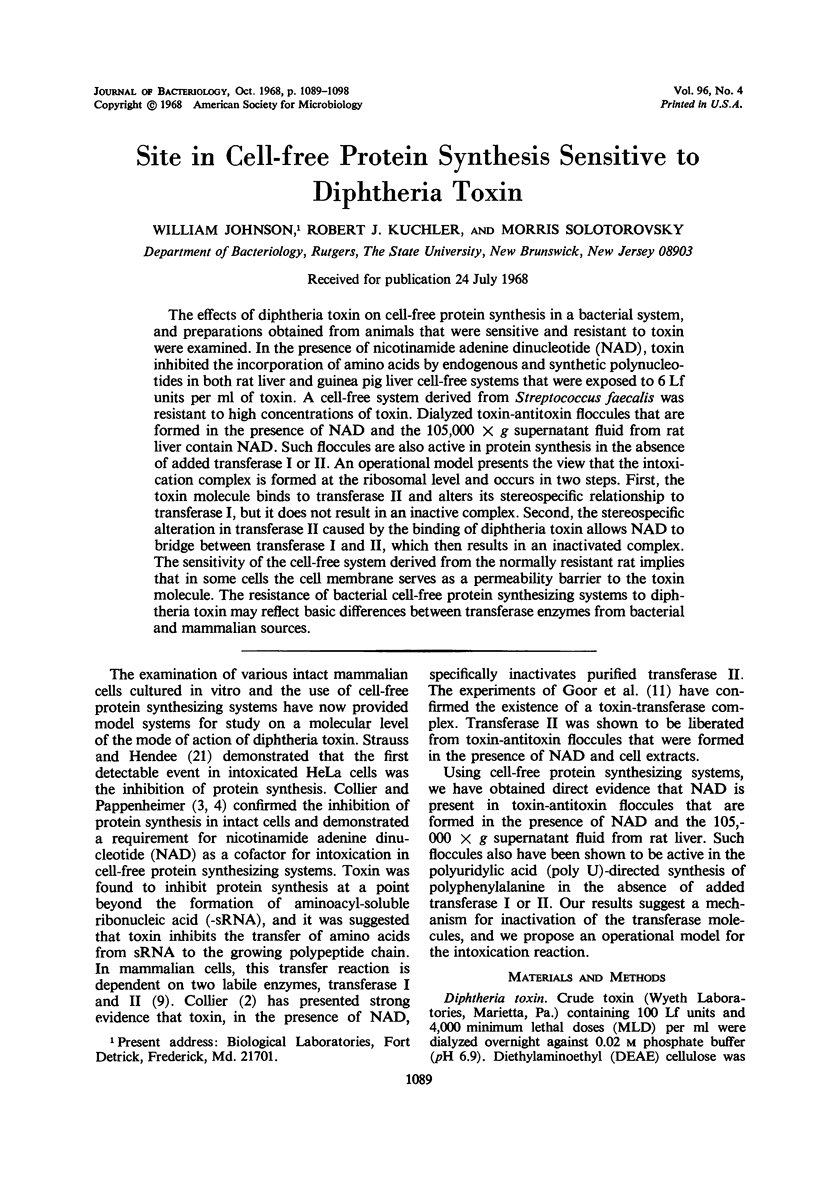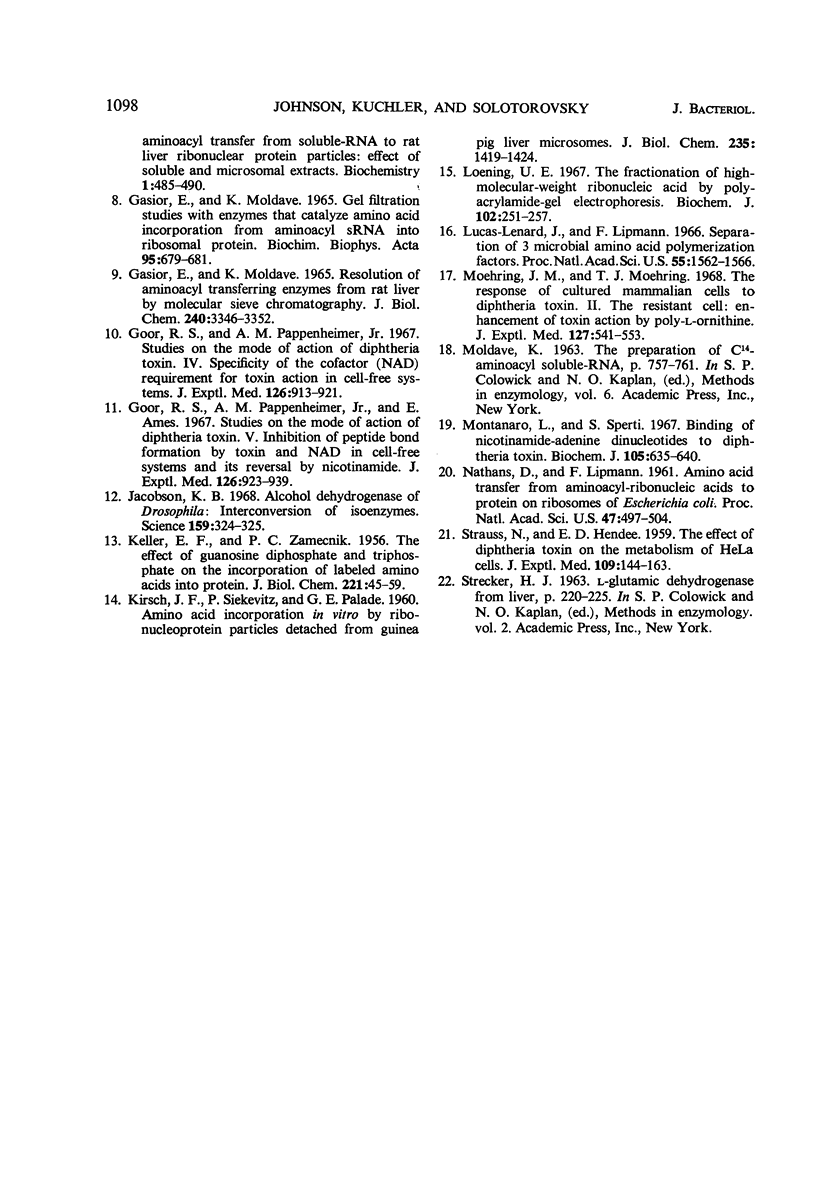Abstract
The effects of diphtheria toxin on cell-free protein synthesis in a bacterial system, and preparations obtained from animals that were sensitive and resistant to toxin were examined. In the presence of nicotinamide adenine dinucleotide (NAD), toxin inhibited the incorporation of amino acids by endogenous and synthetic polynucleotides in both rat liver and guinea pig liver cell-free systems that were exposed to 6 Lf units per ml of toxin. A cell-free system derived from Streptococcus faecalis was resistant to high concentrations of toxin. Dialyzed toxin-antitoxin floccules that are formed in the presence of NAD and the 105,000 × g supernatant fluid from rat liver contain NAD. Such floccules are also active in protein synthesis in the absence of added transferase I or II. An operational model presents the view that the intoxication complex is formed at the ribosomal level and occurs in two steps. First, the toxin molecule binds to transferase II and alters its stereospecific relationship to transferase I, but it does not result in an inactive complex. Second, the stereospecific alteration in transferase I, but it does not result in an inactive complex. Second, the stereospecific alteration in transferase II caused by the binding of diphtheria toxin allows NAD to bridge between transferase I and II, which then results in an inactivated complex. The sensitivity of the cell-free system derived from the normally resistant rat implies that in some cells the cell membrane serves as a permeability barrier to the toxin molecule. The resistance of bacterial cell-free protein synthesizing systems to diphtheria toxin may reflect basic differences between transferase enzymes from bacterial and mammalian sources.
Full text
PDF









Images in this article
Selected References
These references are in PubMed. This may not be the complete list of references from this article.
- COLLIER R. J., PAPPENHEIMER A. M., Jr STUDIES ON THE MODE OF ACTION OF DIPHTHERIA TOXIN. I. PHOSPHORYLATED INTERMEDIATES IN NORMAL AND INTOXICATED HELA CELLS. J Exp Med. 1964 Dec 1;120:1007–1018. doi: 10.1084/jem.120.6.1007. [DOI] [PMC free article] [PubMed] [Google Scholar]
- COLLIER R. J., PAPPENHEIMER A. M., Jr STUDIES ON THE MODE OF ACTION OF DIPHTHERIA TOXIN. II. EFFECT OF TOXIN ON AMINO ACID INCORPORATION IN CELL-FREE SYSTEMS. J Exp Med. 1964 Dec 1;120:1019–1039. doi: 10.1084/jem.120.6.1019. [DOI] [PMC free article] [PubMed] [Google Scholar]
- Cho-Chung Y. S., Pitot H. C. Regulatory effects of nicotinamide on tryptophan pyrrolase synthesis in rat liver in vivo. Eur J Biochem. 1968 Feb;3(4):401–406. doi: 10.1111/j.1432-1033.1967.tb19543.x. [DOI] [PubMed] [Google Scholar]
- Collier R. J. Effect of diphtheria toxin on protein synthesis: inactivation of one of the transfer factors. J Mol Biol. 1967 Apr 14;25(1):83–98. doi: 10.1016/0022-2836(67)90280-x. [DOI] [PubMed] [Google Scholar]
- DAVIS B. J. DISC ELECTROPHORESIS. II. METHOD AND APPLICATION TO HUMAN SERUM PROTEINS. Ann N Y Acad Sci. 1964 Dec 28;121:404–427. doi: 10.1111/j.1749-6632.1964.tb14213.x. [DOI] [PubMed] [Google Scholar]
- GABLIKS J., SOLOTOROVSKY M. Cell culture reactivity to diphtheria, Staphylococcus, tetanus and Escherichia coli toxins. J Immunol. 1962 Apr;88:505–512. [PubMed] [Google Scholar]
- GASIOR E., MOLDAVE K. GEL FILTRATION STUDIES WITH ENZYMES THAT CATALYZE AMINO ACID INCORPORATION FROM AMINOACYL S-RNA INTO RIBOSOMAL PROTEIN. Biochim Biophys Acta. 1965 Apr 19;95:679–681. doi: 10.1016/0005-2787(65)90527-7. [DOI] [PubMed] [Google Scholar]
- GASIOR E., MOLDAVE K. RESOLUTION OF AMINOACYL-TRANSFERRING ENZYMES FROM RAT LIVER BY MOLECULAR SIEVE CHROMATOGRAPHY. J Biol Chem. 1965 Aug;240:3346–3352. [PubMed] [Google Scholar]
- Goor R. S., Pappenheimer A. M., Jr, Ames E. Studies on the mode of action of diphtheria toxin. V. Inhibition of peptide bond formation by toxin and NAD in cell-free systems and its reversal by nicotinamide. J Exp Med. 1967 Nov 1;126(5):923–939. doi: 10.1084/jem.126.5.923. [DOI] [PMC free article] [PubMed] [Google Scholar]
- Goor R. S., Pappenheimer A. M., Jr Studies on the mode of action of diphtheria toxin. IV. Specificity of the cofactor (NAD) requirement for toxin action in cell-free systems. J Exp Med. 1967 Nov 1;126(5):913–921. doi: 10.1084/jem.126.5.913. [DOI] [PMC free article] [PubMed] [Google Scholar]
- Jacobson K. B. Alcohol dehydrogenase of Drosophila: interconversion of isoenzymes. Science. 1968 Jan 19;159(3812):324–325. doi: 10.1126/science.159.3812.324. [DOI] [PubMed] [Google Scholar]
- KELLER E. B., ZAMECNIK P. C. The effect of guanosine diphosphate and triphosphate on the incorporation of labeled amino acids into proteins. J Biol Chem. 1956 Jul;221(1):45–59. [PubMed] [Google Scholar]
- KIRSCH J. F., SIEKEVITZ P., PALADE G. E. Amino acid incorporation in vitro by ribonucleoprotein particles detached from guinea pig liver microsomes. J Biol Chem. 1960 May;235:1419–1424. [PubMed] [Google Scholar]
- Loening U. E. The fractionation of high-molecular-weight ribonucleic acid by polyacrylamide-gel electrophoresis. Biochem J. 1967 Jan;102(1):251–257. doi: 10.1042/bj1020251. [DOI] [PMC free article] [PubMed] [Google Scholar]
- Lucas-Lenard J., Lipmann F. Separation of three microbial amino acid polymerization factors. Proc Natl Acad Sci U S A. 1966 Jun;55(6):1562–1566. doi: 10.1073/pnas.55.6.1562. [DOI] [PMC free article] [PubMed] [Google Scholar]
- Moehring J. M., Moehring T. J. The response of cultured mammalian cells to diphtheria toxin. II. The resistant cell: enhancement of toxin action by poly-L-ornithine. J Exp Med. 1968 Mar 1;127(3):541–554. doi: 10.1084/jem.127.3.541. [DOI] [PMC free article] [PubMed] [Google Scholar]
- Montanaro L., Sperti S. Binding of nicotinamide-adenine dinucleotides to diphtheria toxin. Biochem J. 1967 Nov;105(2):635–640. doi: 10.1042/bj1050635. [DOI] [PMC free article] [PubMed] [Google Scholar]
- NATHANS D., LIPMANN F. Amino acid transfer from aminoacyl-ribonucleic acids to protein on ribosomes of Escherichia coli. Proc Natl Acad Sci U S A. 1961 Apr 15;47:497–504. doi: 10.1073/pnas.47.4.497. [DOI] [PMC free article] [PubMed] [Google Scholar]
- STRAUSS N., HENDEE E. D. The effect of diphtheria toxin on the metabolism of HeLa cells. J Exp Med. 1959 Feb 1;109(2):145–163. doi: 10.1084/jem.109.2.145. [DOI] [PMC free article] [PubMed] [Google Scholar]



